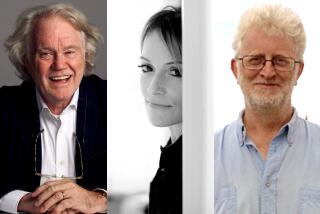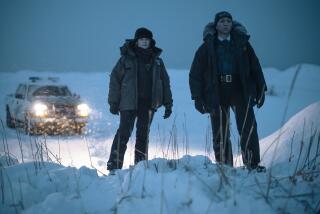A Shot in the Dark
The plot of Daniel Silva’s fifth thriller turns on acts of conscience by several men whose consciences, we would think, had long since been extinguished. It’s a sign of how Silva’s work has declined since his notable debut, “The Unlikely Spy,” that none of these changes of heart are dramatized. They all occur offstage. They aren’t meant to illuminate these men’s characters, because character hardly matters here; they are only devices to turn the plot.
Augustus Rolfe, a Swiss banker who helped finance Hitler’s war machine, was rewarded with a collection of French paintings looted by the Nazis. Rolfe’s wife discovered his secret, dug her own grave in the garden of their Zurich villa, lay down in it and shot herself. Rolfe’s daughter, Anna, a concert violinist, is ignorant of the secret but repelled by her father nonetheless. She exiles herself from Switzerland. Many years later, the heretofore unrepentant Rolfe decides to return the paintings to their rightful owners--a plan that alarms other Swiss bankers with caches of stolen art.
For the record:
12:00 a.m. April 13, 2002 FOR THE RECORD
Los Angeles Times Saturday April 13, 2002 Home Edition Main News Part A Page 2 A2 Desk 1 inches; 33 words Type of Material: Correction
Book review--In the review of “The English Assassin,” (Book Review, March 31), it was incorrectly stated that author Daniel Silva attributed to Brahms two violin concertos when in fact Silva accurately wrote that Brahms wrote only one.
For the Record
Los Angeles Times Sunday April 14, 2002 Bulldog Edition Main News Part A Page 2 Advance Desk 1 inches; 34 words Type of Material: Correction
“The English Assassin”--In the March 31 Book Review, the review of “The English Assassin” incorrectly stated that author Daniel Silva attributed to Brahms two violin concertos when in fact Silva accurately wrote that Brahms wrote only one.
For the Record
Los Angeles Times Sunday April 14, 2002 Bulldog Edition Main News Part A Page 2 Advance Desk 1 inches; 34 words Type of Material: Correction
“The English Assassin”--In the March 31 Book Review, the review of “The English Assassin” incorrectly stated that author Daniel Silva attributed to Brahms two violin concertos when in fact Silva accurately wrote that Brahms wrote only one.
For the Record
Los Angeles Times Sunday April 21, 2002 Home Edition Book Review Page 18 Book Review Desk 1 inches; 31 words Type of Material: Correction
In the review of ‘The English Assassin,’ (Book Review, March 31), it was incorrectly stated that author Daniel Silva attributed to Brahms two violin concertos when in fact Silva accurately wrote that Brahms wrote only one.
Rolfe contacts the Israeli government, which sends art restorer Gabriel Allon to Zurich, ostensibly to clean one of Rolfe’s legitimately acquired Old Masters but in fact to smuggle out the French art hidden in his villa. When Allon arrives, however, he finds Rolfe murdered and the paintings stolen. Leaving the scene, he is arrested by Gerhardt Peterson, a Swiss police official in cahoots with the other bankers, and is released only when Israeli intelligence intervenes.
Allon, a repeat Silva hero, is no ordinary art expert. He’s also an Israeli spy, an assassin who has tracked down and killed a number of Palestinian terrorists. He mourns his wife and son, victims of a terrorist’s bomb, and he vomits whenever he has to kill someone. In short, he has a conscience, though it has never slowed his trigger finger.
In contrast, the mysterious Englishman the bankers hire to kill anyone who threatens “the institutions that had given a tiny, landlocked country with few natural resources the world’s second-highest standard of living” seems to enjoy his lethal trade. A former British Army commando, he works out of Corsica, where centuries of vendettas have made the taddunaghiu, or hit man, a feared and respected figure.
Still, whenever he kills someone, he feels the need to visit an old Corsican woman who casts spells to rid him of the “evil eye.” And the arrogant, ambitious Peterson shows a hint of weakness as well: a childhood memory of asking his father about Jewish refugees being handed back over the border to the Nazis. His father confirmed it. The boy was shocked--this didn’t square with what he was taught in school: “that Switzerland, a neutral country during the war, had opened its borders to refugees and wounded soldiers--that it had been Europe’s Sister of Mercy.”
Instead, it squares with nonfiction exposes of Switzerland’s wartime role that Silva acknowledges, such as Lynn Nicholas’ “The Rape of Europa” and Jean Ziegler’s “The Swiss, the Gold, and the Dead.” Swiss banks, the book notes, enabled Hitler to fight on a year longer, at an immense cost in lives; Swiss bankers, aided by secrecy laws, clung to the deposits of Jews killed in the Holocaust and many artworks stolen by the Nazis “remain hidden in the vaults of Switzerland’s banks and in the homes of its citizens.”
As an indictment, “The English Assassin” is powerful. As a story, though, it’s mostly travelogue. As Allon, enlisting Anna Rolfe’s help, tries to re-enter Switzerland to find the paintings and unmask the villains, and as Peterson and the Englishman try to stop them, the action jumps from London to Zurich to Tel Aviv to Vienna to Lisbon to Venice. In each place, Silva describes the architecture, the weather, the history; he names streets and buildings, passes on some local slang.
His aim, of course, is to give the story credibility, but when such expertise becomes the story--a common failing with thrillers--any lapse hurts. (Anna Rolfe, for example, records a CD of “several Brahms violin concertos,” but Brahms wrote only one.) It was different with “The Unlikely Spy,” in which Silva’s evocation of Britain during World War II was absorbing and convincing, and in which his hero, a professor uneasily working in espionage, was a human being--not a robot who, when shot or stabbed, is as likely to leak hydraulic fluid as blood.


